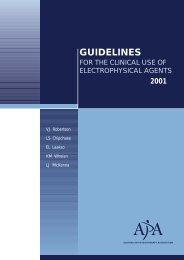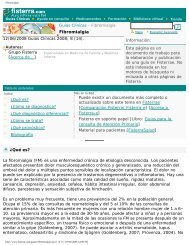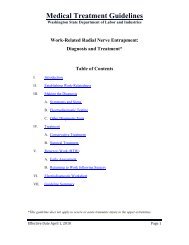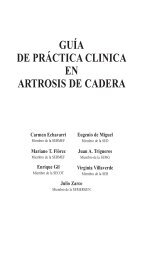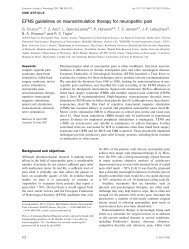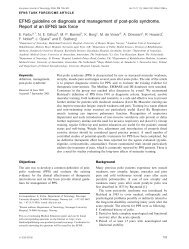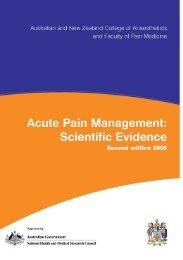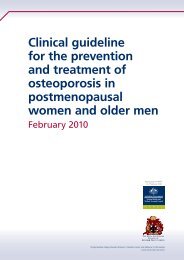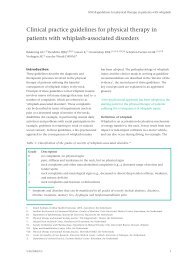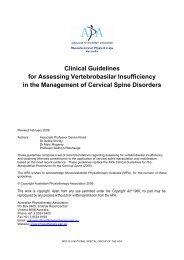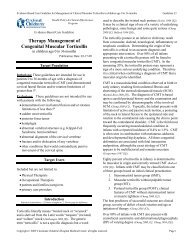Practice Parameter and Literature Review of the Usefulness of ...
Practice Parameter and Literature Review of the Usefulness of ...
Practice Parameter and Literature Review of the Usefulness of ...
Create successful ePaper yourself
Turn your PDF publications into a flip-book with our unique Google optimized e-Paper software.
<strong>Practice</strong> <strong>Parameter</strong>: Carpal Tunnel Syndromeamplitude ratio between median SNAP to index finger/ulnar SNAP to<strong>the</strong> little finger. One hundred thirty-one abnormal h<strong>and</strong>s in 123subjects <strong>and</strong> 38 normal h<strong>and</strong>s in 38 people were evaluated withanalysis focused on <strong>the</strong> 40 h<strong>and</strong>s in <strong>the</strong> mild CTS group. Symptomswere systematically recorded <strong>and</strong> reported in each patient. Themedian-radial latency difference to <strong>the</strong> thumb <strong>and</strong> median-ulnarlatency difference to ring finger was slightly more sensitive than <strong>the</strong>midpalm studies. Amplitude ratios were very insensitive.111. Jhee WH, Oryshkevich RS, Wilcox R. Severe carpal tunnel syndromewith sparing <strong>of</strong> sensory fibers. Orthop Rev 1986;15:103-106. CriteriaMet (0/6) Source: Medline Search.112. Johnson EW, Kukla RD, Wongsam PE, Piedmont A. Sensorylatencies to <strong>the</strong> ring finger: normal values <strong>and</strong> relation to carpal tunnelsyndrome. Arch Phys Med Rehabil 1981;62:206-208. Criteria Met(3/6: 1,3,5) Source: Redmond, 1988. Abstract: With stimulation at <strong>the</strong>wrist <strong>and</strong> recording over <strong>the</strong> ring finger, <strong>the</strong> median <strong>and</strong> ulnar nerveDSL were recorded across <strong>the</strong> wrist; 37 normal subjects <strong>and</strong> 18 cases<strong>of</strong> CTS were evaluated. The difference between median <strong>and</strong> ulnarDSL to <strong>the</strong> ring finger was abnormal in all 18 CTS patients.113. Johnson EW, Melvin JL. Sensory conduction studies <strong>of</strong> median <strong>and</strong>ulnar nerves. Arch Phys Med Rehabil 1967;48:25-30. Criteria Met(4/6: 1,3,5,6) Source: Dunnan, 1991. Abstract: With stimulation <strong>of</strong> <strong>the</strong>middle or index finger <strong>and</strong> recording over <strong>the</strong> median nerve at <strong>the</strong>wrist, orthodromic SNAPs <strong>and</strong> DSLs were determined in 120controls. Orthodromic ulnar SNAPs <strong>and</strong> DSL were determined afterstimulation <strong>of</strong> <strong>the</strong> ring finger or little finger <strong>and</strong> recording at <strong>the</strong> wrist<strong>and</strong> 44 controls. They report cases <strong>of</strong> abnormal DSL in patients withcarpal tunnel syndrome, toxic neuropathy, early diabetic neuropathy,<strong>and</strong> o<strong>the</strong>r peripheral nerve involvement problems.114. Johnson EW, Sipski M, Lammertse T. Median <strong>and</strong> radial sensorylatencies to digit I: normal values <strong>and</strong> usefulness in carpal tunnelsyndrome. Arch Phys Med Rehabil 1987;68:140-141. Criteria Met(2/6: 1,3) Source: Medline Search.115. *Jordan SE, Greider JL Jr. Autonomic activity in <strong>the</strong> carpal tunnelsyndrome. Orthop Rev 1987;16:165-169. Criteria Met (2/6: 1,2)Source: Medline Search.116. Joynt RL. Comparison <strong>of</strong> residual latency <strong>and</strong> palmar stimulation fordiagnosis <strong>of</strong> carpal tunnel syndrome. Muscle Nerve 1984;7:565.Criteria Met (0/6) (abstract only) Source: Redmond, 1988.117. Joynt RL. Correlation studies <strong>of</strong> velocity, amplitude <strong>and</strong> duration inmedian nerves. Arch Phys Med Rehabil 1989;70:477-481. CriteriaMet (4/6: 1,3,5,6) Source: Medline Search. Abstract: The followingtechniques were studied: (a) stimulation in <strong>the</strong> palm between <strong>the</strong> third<strong>and</strong> fourth metacarpals <strong>and</strong> median recording at <strong>the</strong> wrist <strong>and</strong> (b)stimulation at <strong>the</strong> wrist <strong>and</strong> CMAP recording over <strong>the</strong> ABP. Distallatencies, amplitudes, duration <strong>of</strong> response <strong>and</strong> residual latencies wereevaluated; 390 patients were studied, all <strong>the</strong>se were symptomatic <strong>and</strong>many <strong>of</strong> <strong>the</strong>m had CTS. The results suggest that amplitude, duration,<strong>and</strong> conduction velocity are relatively poorly correlated <strong>and</strong>independent variables. There is a very high correlation betweenresidual latency <strong>and</strong> distal motor latency, thus suggesting limitedusefulness for residual latency in <strong>the</strong> diagnosis <strong>of</strong> CTS.118. Joynt RL. Differences in sensory conduction velocity betweendifferent sensory branches <strong>and</strong> segments <strong>of</strong> <strong>the</strong> median <strong>and</strong> ulnarnerves. Am J Phys Med Rehabil 1989;68:210-214. Criteria Met (3/6:1,5,6) Source: Medline Search.119. Kabiraj MMU, Al Rajeh S, Al Tahan AR, Abduljabbar M, Al BunyanM, Daif AK, Awada A. Carpal tunnel syndrome: a clinicoelectrophysiologicalstudy. Medical Science Research 1998;26:631-633. Criteria Met (4/6: 2,3,4,5). Source: Medline Search.Retrospective review <strong>of</strong> 5 years record to identify 72 CTS patients57% idiopathic, 19% associated with diabetes mellitus, 11% withrheumatoid arthritis, 7% with hypothyroidism, <strong>and</strong> 6% with renal orheart failure. The group <strong>of</strong> CTS patients showed abnormal mediansensory <strong>and</strong> motor terminal latencies decreased median SNAPamplitude <strong>and</strong> velocity <strong>and</strong> median terminal latency index comparedto a group <strong>of</strong> 65 normal subjects. There was a positive correlationbetween <strong>the</strong> median motor distal latency <strong>and</strong> <strong>the</strong> median terminallatency index. The study did not examine <strong>the</strong> percentage <strong>of</strong> CTSpatients showing each type <strong>of</strong> NCS abnormality.120. Katims JJ, Rouvelas P, Sadler BT, Weseley SA. Current perceptionthreshold: Reproducibility <strong>and</strong> comparison with nerve conduction inevaluation <strong>of</strong> carpal tunnel syndrome. Trans Am Soc Artif InternOrgans 1989;35:280-284. Criteria Met (2/6: 1,2) Source: MedlineSearch.121. Katz JN, Larson MG, Fossel AH, Liang MH. Validation <strong>of</strong> asurveillance case definition <strong>of</strong> carpal tunnel syndrome (comment inAm J Public Health 1991;81:161-162). Am J Public Health1991;81:189-193. Criteria Met (2/6: 1,2) Source: Medline Search.122. Katz JN, Larson MG, Sabra A, Krarup C, Stirrat CR, Sethi R, EatonHM, Fossel AH, Liang MH. The carpal tunnel syndrome: diagnosticutility <strong>of</strong> <strong>the</strong> history <strong>and</strong> physical examination findings (comments inAnn Intern Med 1990;113:254 <strong>and</strong> Ann Intern Med 1990;113:409).Ann Intern Med 1990;112:321-327. Criteria Met (2/6: 1,5) Source:Medline Search.123. Katz JN, Stirrat CR, Larson MG, Fossel AH, Eaton HM, Liang MH.A self-administered h<strong>and</strong> symptom diagram for <strong>the</strong> diagnosis <strong>and</strong>epidemiologic study <strong>of</strong> carpal tunnel syndrome. J Rheumatol1990;17:1495-1498. Criteria Met (3/6: 2,3,4) Source: Medline Search.124. Katz JN, Stirrat CR. A self-administered h<strong>and</strong> diagram for <strong>the</strong>diagnosis <strong>of</strong> carpal tunnel syndrome. J H<strong>and</strong> Surg Am 1990;15:360-363. Criteria Met (1/6: 1) Source: Medline Search.125. Kemble F. Electrodiagnosis <strong>of</strong> <strong>the</strong> carpal tunnel syndrome. J NeurolNeurosurg Psychiatry 1968;31:23-27. Criteria Met (4/6: 1,2,5,6)Source: Winn, 1989. Abstract: With stimulation over thumb, index,middle, <strong>and</strong> ring fingers <strong>and</strong> recording over <strong>the</strong> median nerve at <strong>the</strong>wrist <strong>and</strong> elbow, orthodromic SNAPs <strong>and</strong> CMAPs to <strong>the</strong> APB weredetermined in 120 h<strong>and</strong>s in 66 female patients with CTS. They foundthat <strong>the</strong> DSL was more likely to be abnormal than DML.126. Kiernan MC, Mogyoros I, Burke D. Conduction block in carpaltunnel syndrome. Brain 1999;122(Pt 5):933-941. Criteria Met (4/6:1,4,5,6) Source: Medline Search. Abstract: Prolonged wrist extensionwas performed passively (written communication) in 6 healthysubjects <strong>and</strong> 7 CTS patients. Preliminary experiments demonstratedthat changes in <strong>the</strong> CSAP (compound sensory action potential)developed sooner than changes in <strong>the</strong> CMAP so subsequent studieswere confined to <strong>the</strong> CSAP. During maintained wrist extension to 90degrees, all subjects developed greater than 50% conduction block incutaneous afferents in <strong>the</strong> wrist (but not distal to <strong>the</strong> wrist) <strong>and</strong> slightincreases in distal latency (0.44 ± 0.07 ms for normal subjects <strong>and</strong>0.51 ± 0.05 ms for CTS patients). The changes in normal subjectsbegan after wrist extension for 21.8 ± 5.8 min <strong>and</strong> was maximal at49.3 ± 10.7 min. The changes in CTS patients began after wristextension for 12.8 ± 2.8 min <strong>and</strong> was maximal at 28.1 ± 3.3 min. Thereduction in <strong>the</strong> amplitude <strong>of</strong> <strong>the</strong> SNAP potential in normal subjects<strong>and</strong> CTS patients was associated with changes in axonal excitabilityat <strong>the</strong> wrist with a decrease in supernormality <strong>and</strong> an increase inrefractoriness compatible with axonal depolarization. All subjects(normals <strong>and</strong> patients) reported mild pares<strong>the</strong>siae during prolongedwrist extension <strong>and</strong> more intense pares<strong>the</strong>siae were reportedfollowing <strong>the</strong> release <strong>of</strong> wrist extension. It is concluded that wristextension produces a depolarization block in both normal subjects <strong>and</strong>CTS patients, much as occurs with ischemic compression, but thatthis block cannot be altered merely by compensating for <strong>the</strong> axonaldepolarization. It is argued that conduction block <strong>and</strong> conductionslowing need not always be attributed to disturbed myelination, <strong>and</strong>that ischemic compression may be sufficient to explain some <strong>of</strong> <strong>the</strong>intermittent symptoms <strong>and</strong> electrodiagnostic findings in patients withcarpal tunnel syndrome, particularly when it is <strong>of</strong> mild or moderateseverity.127. Kim LYS. Palmar digital nerve stimulation to diagnose carpal tunnelsyndrome. Orthop Rev 1983;59-63. Criteria Met (4/6: 1,3,5,6)Source: Joynt, 1989. Abstract: With stimulation in <strong>the</strong> midpalm <strong>and</strong>recording at <strong>the</strong> wrist, median <strong>and</strong> ulnar distal latencies <strong>and</strong> medianulnardistal latency differences were determined in 66 h<strong>and</strong>s in 33normal control subjects <strong>and</strong> 50 h<strong>and</strong>s in 39 mild CTS patients. MildCTS was defined as patients who had symptoms who were highlysuggestive <strong>of</strong> CTS, but had normal DSL between <strong>the</strong> finger <strong>and</strong> wrist.Sixty percent <strong>of</strong> <strong>the</strong>se mild CTS patients were abnormal by <strong>the</strong>median-ulnar difference criteria (greater than or equal to 0.4 ms).128. Kimura J. A method for determining median nerve conductionvelocity across <strong>the</strong> carpal tunnel. J Neurol Sci 1978;38:1-10. CriteriaMet (5/6: 1,2,3,5,6) Source: Palliyath, 1990. Abstract: Withstimulation at <strong>the</strong> wrist <strong>and</strong> midpalm <strong>and</strong> recording SNAPs over <strong>the</strong>index finger <strong>and</strong> CMAPs from <strong>the</strong> APB, NCVs were determinedacross <strong>the</strong> carpal tunnel for both motor <strong>and</strong> sensory nerves; 50 h<strong>and</strong>sS966 CTS <strong>Literature</strong> <strong>Review</strong>© 2002 American Association <strong>of</strong> Electrodiagnostic Medicine



